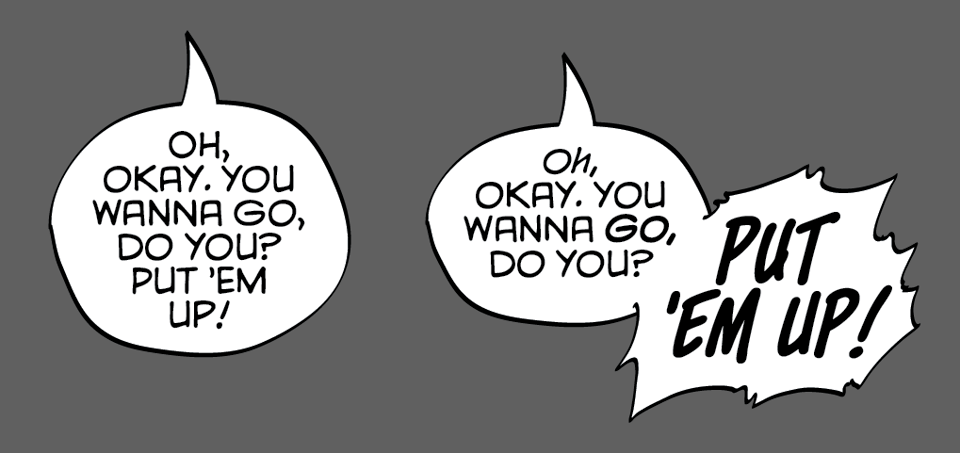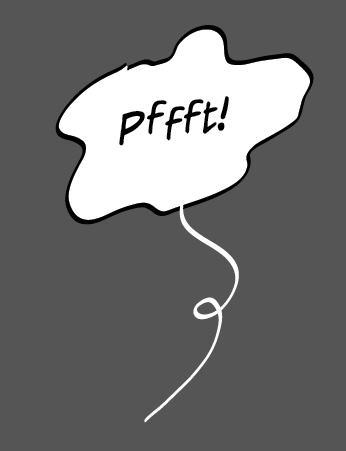The Lettering List 003 - Trucking Along
Hello! Welcome to third edition of The Lettering List! If you've already forgotten, this is the newsletter of...me? I'm Hass, a professional comic book letterer, and every edition I post some random balloons and sound effects from the past few weeks of work, and then we get a little lost in the weeds after that to discuss some facet of lettering comics. So, here we go:
BARK!
 excuse you
excuse you just a classic swearing balloon, honestly
just a classic swearing balloon, honestly I like these offset SFX (which you'll notice if you've read anything I've worked on...)
I like these offset SFX (which you'll notice if you've read anything I've worked on...) textures!!!
textures!!! and people say I can't do a clean balloon!
and people say I can't do a clean balloon! okay, back on some nonsense
okay, back on some nonsense see above.
see above. Okay, so I purposefully picked a bunch of fairly extreme examples for this one, because I wanted to talk a bit about what the job of lettering is (as I see it), and what you can make it be if you want to. If you've ever seen me speak about lettering before, this is lifted a bit from that general talk, but essentially the role of lettering is to make comics readable with the dialogue and captions. Making sure a reader can read the words (size, font legibility, that it prints right, etc.), that they understand who is saying what (tails to the right people, clear, not confusing unless for a reason) and that they can read it in the right order and don't get confused about where to read next (placement on the page, working with the art, etc.). If you can do that, you're kind of hitting the baseline of your job.
Okay, so I purposefully picked a bunch of fairly extreme examples for this one, because I wanted to talk a bit about what the job of lettering is (as I see it), and what you can make it be if you want to. If you've ever seen me speak about lettering before, this is lifted a bit from that general talk, but essentially the role of lettering is to make comics readable with the dialogue and captions. Making sure a reader can read the words (size, font legibility, that it prints right, etc.), that they understand who is saying what (tails to the right people, clear, not confusing unless for a reason) and that they can read it in the right order and don't get confused about where to read next (placement on the page, working with the art, etc.). If you can do that, you're kind of hitting the baseline of your job.
So! If we apply that understanding to working on a multitude of comics, you can letter them as essentially a mostly technical exercise, right? You can find a clean font, a clean balloon, and you can put the words in those balloons and make sure the tails point to the right people and that they're in the correct order, and you can get outta there! That's the job, you're doing what needs to be done. It's not a tonne of fun though, and importantly (before anyone gets annoyed that we're having fun) it ceases to become especially "additive". The value added is clear, of course, but I mean in the sense that there's opportunity (as with other roles of comics) to try and help what is happening in the story and on the page in any given panel.
Now, this means a lot of different things. And it really also depends on what you feel is the letterer's responsibility within the dynamic of your collaboration, too. For me, it's a pretty wide berth, but I would call it identifying how best to present the text within the form and function of comics and the story. So that's about rendering and balloon style, it's about changing the presentation if need be, or even just breaking things up to help the effect.
For example, I will break up dialogue into different balloons if I think it will read better, or if I think rhythmically it makes more sense to do so. The script might say that FRED says, "Oh, okay. You wanna go, do you? Put 'em up!" You could render that in one balloon, or you could split it up into "Oh, okay. You wanna go, do you?" and then a second, burst balloon, "PUT 'EM UP!"

There isn't really a right and wrong answer to that, which is why lettering isn't just a technical role, but it's a creative one, too. There's a choice to be made with every balloon, not just in where it goes on the page, but in how you choose to present it.
I could write about all the different elements for a long while, but I found the easiest way to explain your decision making as a letterer is to consider it as engagement. Are you engaged in the process? Are you understanding what the creative team that has come before you is trying to do? Can you help that, can you add to that? And yes, sometimes, can you just get out of the way and let them do their thing? If you're locked-in in that way, you can look at a screaming balloon of someone being attacked and decide if that just needs to be in a normal balloon, or if there's something else that might sell the severity of the moment. Is it that you need to build up to that over a few pages of a character being beaten up, or do you want to showcase the range of quiet-to-scream as a baddie gets tazed (or whatever).
What I find interesting is considering the different between cartoonists that letter themselves and how comics have treated them outside of that range. Because I think there's ample space to bring cartooning elements into lettering, especially in things like small asides, or what are essentially SFX rendered in balloons (think SNFF or PFFFT or whatever verbal thing a character might do).

And look, as you can tell from the rambling nature of this post, I could talk about this for a while. But maybe it's given you something to think about before inevitably this topic comes up again in this newsletter. And ultimately, this approach is just my opinion! I'm sure a lot of people will disagree, which is what makes this all so much fun. But for me this is a big part of lettering: understanding what your particular role is in this particular creative unit and in this particular comic book. Sometimes a team wants you to push yourself further, try different things, make the lettering a specifically integral part of how the story is told, and sometimes you need to be the bassist, keeping everything trucking along, every once in a while throwing out a little connecting riff to take it all to the chorus. That's really the beauty of the job, how dynamically different every single project can be.
But, ultimately, for me all those different approaches comes back to that same concept. Being engaged in the process of what you're making, and trying to be the best collaborator you can be within that specific team.
--
Yeesh! What are we doing here?! If you're still around this deep into the newsletter, congrats! Anyway, until next time.
Hass
Comics featured in the Lettering List this edition: Beneath the Trees, No/One, [Unannounced project], Beyond Real, and Poison Ivy.
Sneaky plug for my upcoming graphic novel, THE UNLIKELY STORY OF FELIX & MACABBER - created with Juni Ba. It's available to pre-order now here: https://www.amazon.co.uk/Unlikely-Story-Felix-Macabber/dp/1506738222